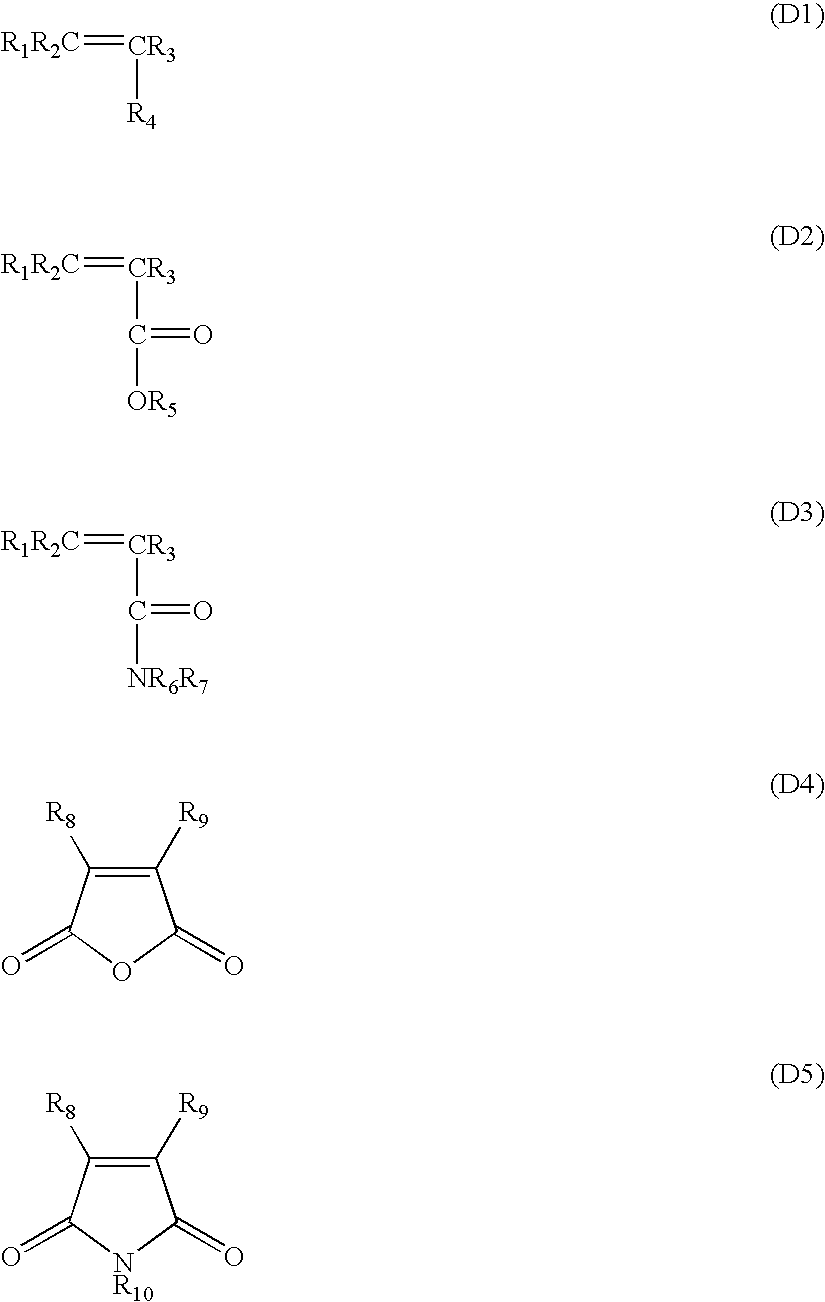Multi-layer imageable element with improved properties
a multi-layer, imageable technology, applied in thermography, instruments, photosensitive materials, etc., can solve the problems of time-consuming process and small change in mask dimensions, and achieve the effect of improving post-development bakeability (or curability), fast digital speed and improving resistance to pressroom chemicals
- Summary
- Abstract
- Description
- Claims
- Application Information
AI Technical Summary
Benefits of technology
Problems solved by technology
Method used
Image
Examples
synthesis example s1
Polymer A-Inventive
[0160]AIBN (0.4 g), PMI (4.0 g), acrylonitrile (9.0 g), methacrylic acid (2.0 g), N-methoxy methyl methacrylamide (3.0 g), methacrylamide (2.0 g), and DMAC (80 g) were placed in a 500-ml 3-necked flask, equipped with magnetic stirring, temperature controller, condenser, and N2 inlet. The reaction mixture was heated to 60° C. and stirred under N2 protection for 16 hours after which AIBN (0.1 g) was added and the reaction was continued for another 6 hours. The reaction mixture was slowly dropped into 3000 ml of ice water while stirring and a precipitate was formed. After filtration and drying at below 50° C., 16.2 g of the desired solid polymer were obtained.
[0161]Polymer A was evaluated for its solubility (solvent resistance) by mixing 0.502 g of Polymer A with 20.0 g of 80% 2-butoxyethanol (in water) and stirring overnight (˜16 h) at 25° C. The resulting mixture was filtered and washed with 20 ml of water three times. The recovered Polymer A was dried at 45° C. fo...
synthesis example s3
Polymer C-Comparative, without Recurring Unit A
[0163]AIBN (0.3 g), PMI (7.0 g), acrylonitrile (10.0 g), methacrylic acid (3.0 g), and DMAC (80 g) were placed in a 500-ml 3-necked flask, equipped with magnetic stirring, temperature controller, condenser, and N2 inlet. The reaction mixture was heated to 60° C. and stirred under N2 protection for 16 hours. The reaction mixture was slowly dropped into 2000 ml of ice water while stirring and a precipitate was formed. After filtration and drying at below 50° C., 16 g of the desired solid polymer were obtained.
SYNTHESIS EXAMPLE S4
Polymer D-Comparative, Without Recurring Unit B
[0164]AIBN (0.4 g), PMI (10.0 g), methacrylic acid (3.0 g), N-methoxy methyl methacrylamide (2.0 g), methacrylamide (5.0 g), and DMAC (80 g) were placed in a 500-ml 3-necked flask, equipped with magnetic stirring, temperature controller, condenser and N2 inlet. The reaction mixture was heated to 80° C. and stirred under N2 protection for 16 hours. The reaction mixture...
synthesis example
S8
Polymer G-Comparative
[0168]Methyl cellosolve (199.8 g), N-methoxymethyl methacrylamide (18 g), benzyl methacrylate (11.4 g), methacrylic acid (3 g), dodecyl mercaptan (0.075 g), and AIBN (0.6 g) were added to 500 ml 4-neck ground glass flask, equipped with a heating mantle, temperature controller, mechanical stirrer, condenser, pressure equalized addition funnel and nitrogen inlet. The reaction mixture was heated to 80° C. under nitrogen atmosphere. Then, a pre-mixture of N-methoxymethyl methacrylamide (55 g), benzyl methacrylate (34 g), methacrylic acid (9 g), dodecyl mercaptan (0.225 g), and AIBN (1.2 g) were added over two hours at 80° C. The reaction mixture was continued another eight hours and AIBN (0.35 g) was added two more times. The resin solution was precipitated in powder form using DI water / Ice (3:1) and a Lab Dispersator (4000 RPM) and then filtered. The resulting powder was dried at room temperature for 24 hours. The next day, a tray containing the desired polymer w...
PUM
| Property | Measurement | Unit |
|---|---|---|
| weight % | aaaaa | aaaaa |
| weight % | aaaaa | aaaaa |
| weight % | aaaaa | aaaaa |
Abstract
Description
Claims
Application Information
 Login to View More
Login to View More - R&D
- Intellectual Property
- Life Sciences
- Materials
- Tech Scout
- Unparalleled Data Quality
- Higher Quality Content
- 60% Fewer Hallucinations
Browse by: Latest US Patents, China's latest patents, Technical Efficacy Thesaurus, Application Domain, Technology Topic, Popular Technical Reports.
© 2025 PatSnap. All rights reserved.Legal|Privacy policy|Modern Slavery Act Transparency Statement|Sitemap|About US| Contact US: help@patsnap.com



